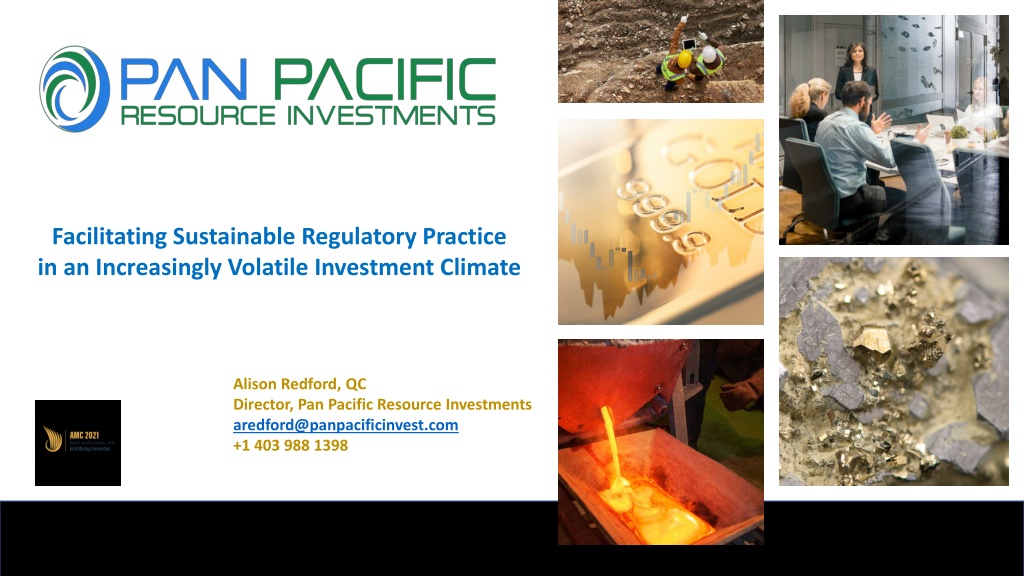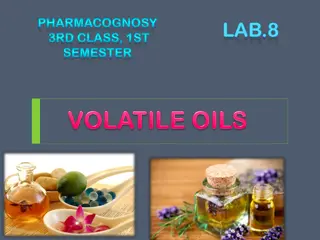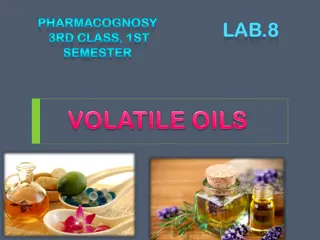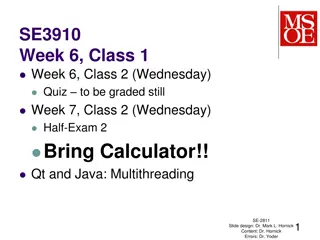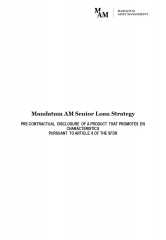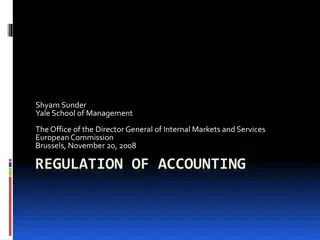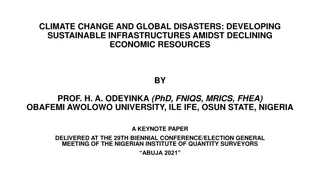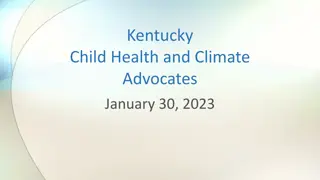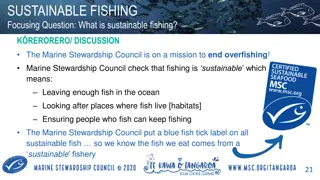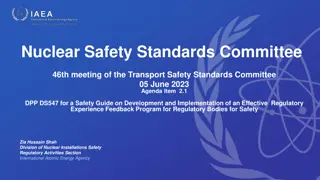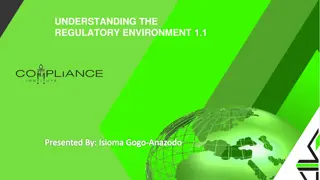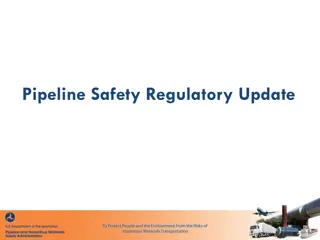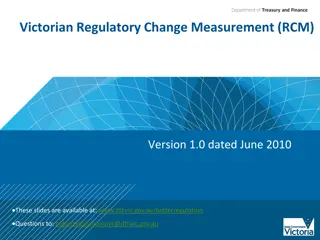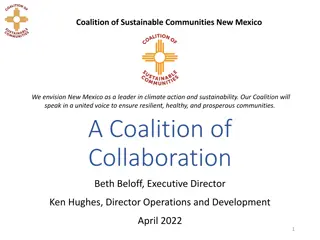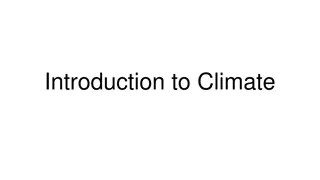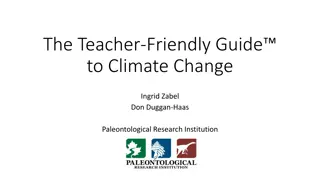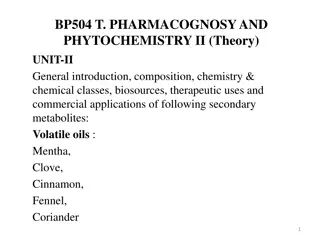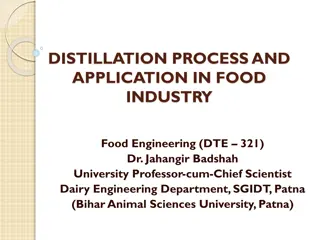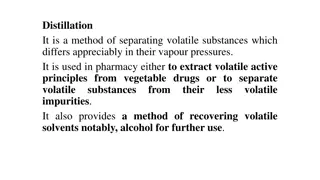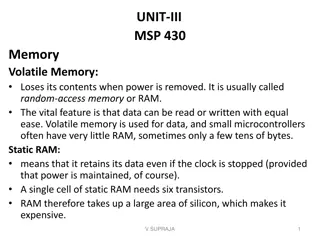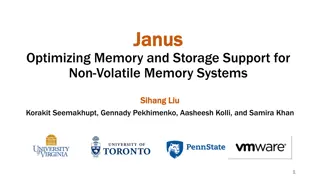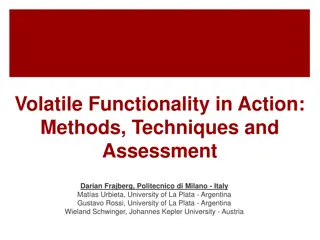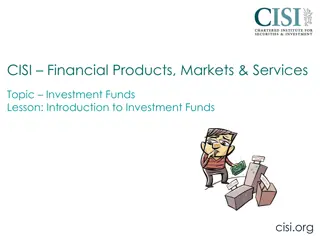Sustainable Regulatory Practices in Volatile Investment Climate
Alison Redford, Director at Pan Pacific Resource Investments, discusses the importance of sustainable regulatory practices in the face of increasing volatility in the investment climate. The focus is on initiatives such as UN Sustainable Development Goals, the Paris Agreement, and Community Benefit Agreements (CBAs) to foster sustainable development and ensure community participation in major projects.
Download Presentation

Please find below an Image/Link to download the presentation.
The content on the website is provided AS IS for your information and personal use only. It may not be sold, licensed, or shared on other websites without obtaining consent from the author. Download presentation by click this link. If you encounter any issues during the download, it is possible that the publisher has removed the file from their server.
E N D
Presentation Transcript
Facilitating Sustainable Regulatory Practice in an Increasingly Volatile Investment Climate Alison Redford, QC Director, Pan Pacific Resource Investments aredford@panpacificinvest.com +1 403 988 1398
Increased Focus on Sustainability UN Sustainable Development Goals https://sdgs.un.org/2030agenda Adopted by all United Nations Member States in 2015 The Paris Agreement https://unfccc.int/process-and-meetings/the-paris-agreement/the-paris-agreement Adopted by 196 Parties at COP 21 in Paris, December 2015 Entered into force November 2016. The Equator Principles https://equator-principles.com A risk management framework, adopted by financial institutions, for determining, assessing and managing environmental and social risk in projects. Latest update of the Principles, released November 2019.
Community Benefit Agreements (CBAs) What is a CBA? CBAs are contractual arrangements between developers and coalitions of community organizations, addressing a broad range of community needs. They are safeguards to ensure that affected residents share in the benefits of major developments.
Community Benefit Agreements (CBAs) When Can We Use a CBA? CBAs are used in a variety of circumstances; 1. Where government regulations specifically require developers to enter into a formal agreement (Papua New Guinea and Mongolia); 2. Where indigenous lands are present and there is a legal requirement to negotiate the conditions of access/use with the traditional landowners (Canada, Australia, Colombia); and 3. Where there have been historical conflicts between a developer and local communities, and the developer has voluntarily negotiated an agreement in an effort to resolve these conflicts. This trend has been driven by increasing expectations that sector investor partners will contribute positively to the long-term development goals of affected communities and countries.
Community Benefit Agreements (CBAs) Process is as Important as the Product Establish better relations with affected communities and other stakeholders Tie together engagement initiatives and bring multiple stakeholder groups to the negotiating table Define common priorities and mutually beneficial objectives Define the roles and responsibilities of various stakeholders, over the project life, in a way that maximizes program effectiveness Build community capacity for negotiation and agreement making Build community knowledge about the industry in question Build the relationships between the various players Establish trust and respect while providing a framework for contract transparency, ongoing dialogue, and partnership
Community Benefit Agreements (CBAs) Fundamental Elements for Success Outline of parties responsibilities, obligations and accountabilities; Timeframe for negotiations Stakeholder mapping to include a definition of community and stakeholders Dispute Resolution Mechanisms and Grievance Provisions.
Community Benefit Agreements (CBAs) Foundational Questions Goals and objectives of the CBA Who will manage the agreement Who will represent the community persons, board, trust, Community members involvement in implementation How will the community benefit Monitoring plans Funding requirements and transparency
Community Benefit Agreements (CBAs) Timeframe and Process Start dialogue as early as possible during preliminary engagement, negotiations, planning activities, conceptual design, (pre)feasibility, exploration and production phases Creating trust takes time, but is critical to success.
What are the outcomes of the Participatory Approach? Community Engagement Capacity Development Clarity and Transparency
What are the outcomes of the Participatory Approach? Community Engagement Increased participation of community, government, and stakeholders in how benefits will be managed and implemented. Enhance dialogue on local development goals Build trust and establish a framework for engagement over the life of the project, providing certainty to investors.
What are the outcomes of the Participatory Approach? Capacity Development Identify capacity building needs, Help communities build capacity for negotiation and project planning and implementation so that they understand the benefits to the community and that renegotiation of CBAs puts those at risk. Help communities understand the industry and operating constraints Maximize benefits to communities.
What are the outcomes of the Participatory Approach? Clarity and Transparency Establish framework for the relationship between the company and community by clarifying responsibilities Specify where benefits will be directed and allocated. Help parties clarify and manage expectations & establish a transparent framework with measurable outcomes.
Mitigation Action Plans & Scenarios (MAPS) MAPS combines facilitated stakeholder processes with research. The programme will support South-South collaboration between developing countries in their plans to implement more ambitious mitigation actions. ERC, in collaboration with SouthSouthNorth, will focus on supporting researchers in MAPS countries, in analysing actions and how that can contribute to achieving targets and overall reductions in the growth of emissions. MAPS builds on the experience of South Africa s long-term mitigation scenarios. MAPS activities in each country will crucially include a participative process with stakeholders from all sectors. In this sense, MAPS is not only another research study but the information will be produced in partnership with the best indigenous and international research. It will strongly build on existing in-country research capacity, feeding information into a national process run by the country. https://mapsprogramme.org
International Examples Ghana Newmont Ahafo Mine Development Foundation Agreement Newmont Ahafo Development Foundation (NADeF) is a sustainable community development Foundation, which was established in May 2008 through a Foundation Agreement developed and signed between Newmont Ghana Gold Limited and the Ahafo Social Responsibility Forum (represented by 10 Ahafo Mine Communities, Local Government, Regional Government and Civil Society), to share resources granted to the Foundation through an annual contribution from Newmont to support community development programs in the area of the Ahafo Mines operations. https://nadef.org Newmont Ahafo Mine Development Foundation Agreement http://ccsi.columbia.edu/files/2016/11/Ghana-Ahafo-Mine-Local-Community-Newmont-Ghana-Gold-Ltd-2008- Development-Foundation-Agreement.pdf Contains multiple types of financial benefit sharing. The agreement requires the company to pay to a community foundation US$1 for every ounce of gold sold from the mine, as well as 1 per cent of the company s net pre-tax income, and of any gains made in selling assets that total US$100,000 or more.
International Examples - Australia Argyle Diamond Mine Participation Agreement Traditional Owners of the Argyle mine area signed a Participation Agreement with Argyle that provides a formal and binding acknowledgement of Traditional Owners' rights and interests, including native title rights, in the mining lease area. The Agreement, which was registered by the National Native Title Tribunal as an Indigenous Land Use Agreement in April 2005, builds significantly on the Good Neighbour Agreement, signed in 1980, under which Argyle continues to make annual payments to local indigenous communities for access to the mining lease area. https://www.gelganyem.com.au/home/our-agreement-gelganyem.html Argyle Diamond Mine Participation Agreement, Indigenous Land Use 2005 https://www.atns.net.au/agreement?EntityID=2591 Details each of the precursor agreements made between the parties and annexes in full the Memorandum of Understanding that sets out negotiating principles and stages, the substantive issues for negotiation and the financial assistance Argyle would provide for the negotiation process. According to the MOU, Argyle would give the Kimberley Land Council (KLC) an advance payment which would then be followed by payments to meet KLC s expenses during negotiations.
International Examples Papua New Guinea Porgera Gold Mine Porgera Joint Venture http://www.porgerajv.com The Porgera Gold Mine is located in the Enga Province of Papua New Guinea at an altitude of 2,200 2,700 meters. It is 130 kilometers west of Mt Hagen and 600 kilometers northwest of the capital Port Moresby. The Porgera Joint Venture (PJV) owns the Porgera Mine which is operated by Barrick (Niugini) Limited ("BNL") on behalf of the JV partners. BNL owns 95 per cent of PJV while the remaining 5% is owned by Mineral Resource Enga (MRE) Limited, which is a consortium between the Enga Provincial Government (2.5%) and the Porgera landowners (2.5%). Corporate Social Responsibility http://www.porgerajv.com/Community-Environment/Corporate-Social-Responsibility
International Examples Canada Black River Gold Project - Nunavut Sabina & Kitikmeot Inuit Association Announce Binding Term Sheet for Land Tenure and Inuit Benefits for the Back River Gold Project, Nunavut https://www.sabinagoldsilver.com/news/sabina-and-kitikmeot-inuit-association-announce-binding-term- sheet-for-land-tenure-and-inuit-benefits-for-the-back-river-gold-project-nunavut-canada
International Examples Canada Diavik Diamonds Project Diavik Diamonds Project, Socio-Economic Monitoring Agreement between Diavik Diamond Mines Inc., the Government of the Northwest Territories, and Aboriginal signatories and parties (October 2, 1999) Business Development - Monitoring of Agreement Implementation Group Advisory Board https://www.miningnorth.com/_rsc/site-content/library/economics/Diavik_Socio- Economic_Monitoring_Agreement_1999.pdf
International Examples Key Principles Respect and Inclusion of Community Flexibility in the Agreement Based on Community Needs Building Trust Short Tern and Long Term
Thank you Alison Redford, QC Director, Pan Pacific Resource Investments aredford@panpacificinvest.com +1 403 988 1398
